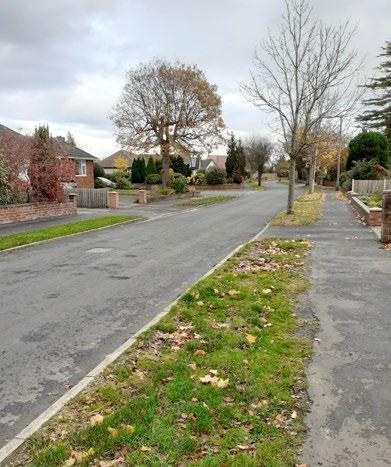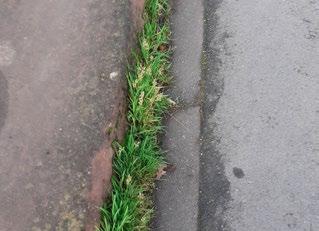
7 minute read
Eric Greenwood
kindly supplied previous records and a map of the monad distribution of Orobanche minor s.l. in the vicecounty. He revealed there had been less than fifteen individual records mapped in ten monads. Graham (1988) listed only three localities, two pre-1940 sites in clover fields in the Tyne Valley, one near Ryton (NZ1564), supporting a population of ‘almost a thousand plants’ and a third from 1973 in grassland adjacent to an old colliery railway, near Chopwell Wood (NZ1458). All other records are post-1988, mostly from the 21st century and probably for O. minor var. heliophila.
References
Advertisement
Graham, G.G. 1988. The flora and vegetation of County Durham.
Durham Flora Committee and Durham County
Conservation Trust. Joel, D.M., Gressel, J. & Musselman, L.J. 2013. Parasitic
Orobanchaceae. Parasitic Mechanisms and Control Strategies.
Springer Nature, Berlin & Heidelberg. Jones, M. 1989. Studies in the pollination of Orobanche species in the British Isles. Progress in Orobanche Research Proceedings 1989: 6–17. Rumsey, F.J. & Jury, S.L. 1991. An account of Orobanche L. in
Britain and Ireland. Watsonia 18: 257–295. Thorogood, C.J., Rumsey, F.J., Harris, S.A. & Hiscock,
S.J. 2008. Host-driven divergence in the parasitic plant
Orobanche minor Sm. (Orobanchaceae). Molecular Ecology 17 (19): 4289–4303. Thorogood, C.J., Rumsey, F.J., Harris, S.A. & Hiscock,
S.J. 2009a. Gene flow between alien and native races of the holoparasitic angiosperm Orobanche minor (Orobanchaceae). Plant Systematics and Evolution 282: 31–42. Thorogood, C.J., Rumsey, F.J. & Hiscock, S.J. 2009b. Hostspecific races in the holoparasitic angiosperm Orobanche minor: implications for speciation in plants. Annals of Botany 103 (7): 1005–1014. Thorogood, C.J. & Rumsey, F.J. 2020. An account of common broomrape Orobanche minor (Orobanchaceae) in the British
Isle. British & Irish Botany 2(3): 223–239. USDA www.plants.usda.gov/core/profile?symbol=ORMI (date of access: 23 August 2020)
Patricia S. Graham
3 The Willows, Bishop Auckland DL14 7HH
David W. Shimwell
shimwell44@tiscali.co.uk
Pavement plants in the Wirral
ERIC GREENWOOD
Covid-19 has prevented many of us venturing far in our botanical rambles, necessitating closer study of our immediate neighbourhood. As the season progressed it became apparent my local council had abandoned street maintenance. Without the application of herbicides and street cleaning, plants appeared where few normally get a chance to grow.
In my local suburban streets in Heswall, Wirral (v.c.58 Cheshire) garden boundaries are often made of brick, concrete or sandstone walls. Pavements are either tarred or made of concrete flags and both are occasionally interrupted by manhole covers. Between the pavement and the carriageway, a mown grass strip with street trees may occur and this is separated from the carriageway by a stone or concrete kerb. During the year plants appeared in the cracks and joints in the hard surfaces.
Accordingly, in late August 2020 two adjacent monads (SJ2880 and SJ2781) were surveyed, but only the plants growing in the cracks and joints of hard surfaces were recorded. The grass verge and garden walls were ignored. Up to two hours was spent recording in each monad but a few species known to have been present early in the year but no longer visible were included, e.g. annuals such as Erophila verna s.l. (Common Whitlowgrass).
This survey is similar to the street survey carried out in Dundee in 2001 and 2020 (Ballinger, 2020) where boundary walls were also included.
Results
A total of 144 taxa were recorded, with 102 and 103 taxa found in each of the two monads. Sixty species were found in both monads, leaving 84 species having been found in only one monad. Forty-three
percent of the taxa were annuals with 57 percent perennials and biennials and of these 14 species were woody and six were trees recorded as seedlings.
As the habitat is normally free of plants, all those recorded are therefore pioneer colonisers of bare ground in a suburban area. With the early arrival of trees, the succession would lead to scrub and woodland. This woodland would consist of Acer pseudoplatanus (Sycamore), Eucalyptus cf. gunnii (Cider Gum), Fraxinus excelsior (Ash), Ulmus sp. (Elm species), Laburnum anagyroides (Laburnum) and Populus alba (White Poplar); not the usual constituents of British woodland. The presence of a Eucalyptus seedling was surprising and of the numerous species native to Australia only a few are cultivated in Britain and Ireland. Of these E. gunnii is the most widely found and in Wirral produces abundant fruits. Quercus spp., Fagus sylvatica (Beech) and Tilia × europaeae (Lime) are common Wirral street trees but no seedlings of these taxa were found. It is possible that acorns were too large to lodge in the narrow cracks whilst Tilia × europaea may be largely sterile. The absence of Fagus sylvatica seedlings is more difficult to explain. Of the other woody species, no doubt Buddleja davidii (Butterfly-bush), (Hedera helix (Common Ivy), Rubus fruticosus agg. (Bramble) and Ulex europaeus (Gorse) would be prominent in a shrub layer of the future woodland.
Most taxa (78%) were natives or archaeophytes, but the remaining neophytes (22% or 32 species) are of some interest. According to the BSBI Distribution Database (DDb) about half were first recorded in Cheshire before 1966, including several in the 19th century, e.g. Veronica persica (Common Fieldspeedwell) (1858) and Geranium pyrenaicum (Hedgerow Crane’s-bill) (1873). Seven species were first recorded since 2000. Verbena bonariensis (Argentine Vervain), Campanula medium (Canterbury-bells) and Lavandula angustifolia (Garden Lavender) are garden escapes. However, Polypogon viridis (Water Bent), Erigeron sumatrensis (Guernsey Fleabane) and E. floribundus (Bilbao’s Fleabane) are recent introductions and all are rapidly becoming more frequent. Polypogon viridis, especially, since first recorded in Wirral in 2012 (DDb) has become the commonest plant found at
A typical street in Heswall with garden wall, pavement, grass verge, street and garden trees, November 2020. Eric Greenwood
the base of garden walls. The origin of introduced species is varied but many are garden or agricultural escapes.
The surveyed roads included bus routes, which are salted in winter. Unsurprisingly 18 species (12%) showed some salt tolerance. These included Catapodium marinum (Sea Fern-grass), Cochlearia danica (Danish Scurvygrass) and Lobularia maritima (Sweet Alison) all with Ellenberg salt tolerance values of 3 or 4 (Hill et al., 2004).
Average Ellenberg values for reaction (pH) were 6.5 (Table 1) and for nitrogen (fertility) 5.5 (Table2). This indicates that overall, pavement plants favoured neutral soils of intermediate fertility. Nevertheless, there were species that favoured more acid soils, e.g. Agrostis capillaris (Common Bent) and Juncus effusus (Soft-rush) and others more alkaline ones, e.g. Anisantha sterilis (Barren Brome), Artemisia vulgaris (Mugwort), Malva neglecta (Dwarf Mallow) and
Medicago lupulina (Black Medick). Similarly, there were wide variations in substrate fertility attributes. A few species were characteristic of infertile soils, e.g. Arabidopsis thaliana (Thale Cress), Briza maxima (Greater Quaking-grass), Erigeron karvinskianus (Mexican Fleabane) and Sedum acre (Biting Stonecrop), whilst others favoured highly fertile substrates, e.g. Alliaria petiolata (Garlic Mustard), Urtica dioica (Common Nettle), Conium maculatum (Hemlock) and Galium aparine (Cleavers).
Table 1. Reaction values
Value Number of taxa 4 6 5 6 6 43 7 64 8 7 Average 6.5
Table 2. Nitrogen values Value Number of taxa 2 5 3 7 4 17 5 25 6 36 7 31 8 5 Average 5.5
Comparison with Dundee street flora
Although a direct comparison with Ballinger’s study cannot be made the street flora of Heswall is significantly richer with 144 taxa recorded as opposed to 90 in Dundee. All the most frequently occurring species in Dundee occurred in both monads in Heswall and are probably as frequent. In addition, Polypogon viridis is abundant in Heswall and this has probably not spread as far north as Dundee. However, he also recorded Asplenium rutamuraria (Wall-rue), presumably on walls. This was present on Heswall garden walls and similarly Campanula poscharskyana (Trailing Bellflower), an increasing species in Dundee, was a common constituent of the Heswall garden wall flora but was not found on pavements or roadsides. Ballinger recorded Epilobium ciliatum (American Willowherb) as an increasing species but surprisingly it was not recorded in the Heswall monads yet is frequent in the neighbourhood. However, the hybrid with Epilobium montanum (Broad-leaved Willowherb), E. ×interjectum, was recorded.

Water Bent (Polypogon viridis) growing at the junction of a sandstone wall and pavement (November 2020); a typical habitat. Eric Greenwood
Conclusion
This exercise proved rewarding and revealed initial colonisation of cracks in hard surfaces of pavements and roadside kerbs involved a wide variety of plants, demonstrating that scrub and woodland would soon develop if allowed to do so. Alien or introduced species were prominent and amongst the newcomers Erigeron species and Polypogon viridis have become abundant within a few years of arrival.
The full list of species is available on request and a copy has been sent to the Vice-county Recorder, Graeme Kay. Shortly after the survey the council resumed street maintenance and most of the plants were killed with herbicide and/or removed.
References
Ballinger, B. 2020. 25 streets in Dundee – 19 years on. Botany in Scotland Blog at WordPress.com Hill, M.O., Preston, C.D. & Roy, D.B. 2004. PLANTATT.
Centre for Ecology & Hydrology, Abbots Ripton.
Eric F. Greenwood
10 Gayton Parkway, Wirral CH60 3SS









